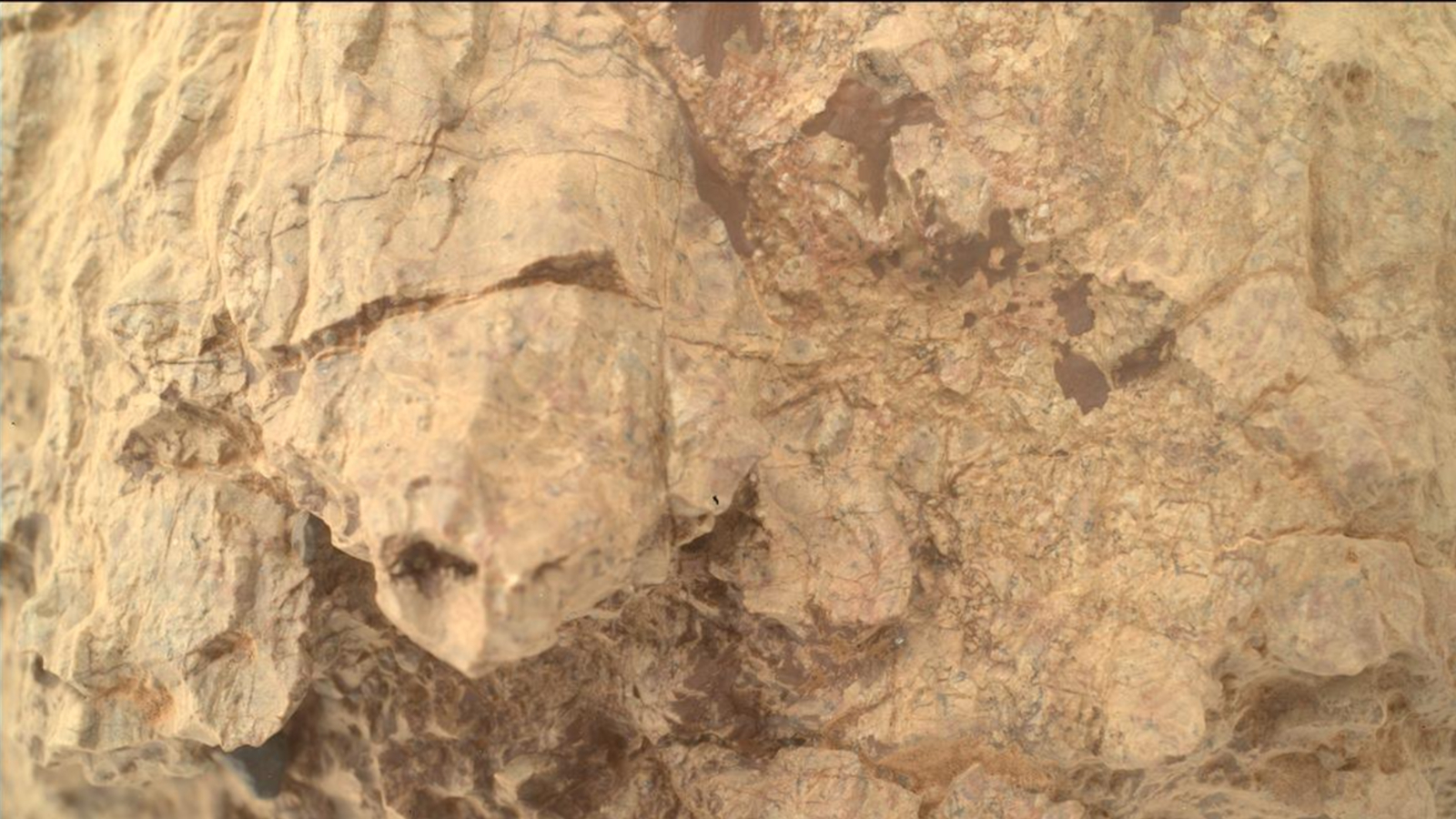By Harry Baker
Copyright livescience

Skip to main content
Close main menu
Live Science
Sign up to our newsletter
View Profile
Search Live Science
Planet Earth
Archaeology
Physics & Math
Human Behavior
Science news
Life’s Little Mysteries
Science quizzes
Newsletters
Story archive
Bright orange shark discovered
Egyptian queen coin found in Jerusalem
Do humans and chimps share 99% DNA?
Comet 3I/ATLAS’s tail growing
Blood moon in photos
Don’t miss these
NASA’s Perseverance rover spies mysterious ‘helmet’ on Mars
NASA finds multi-billion-year-old ‘coral’ on Mars
Mars rover captures first close-up photos of giant ‘spiderwebs’ on the Red Planet
Why does Mars look purple, yellow and orange in ESA’s stunning new satellite image?
Dozens of mysterious blobs discovered inside Mars may be the remnants of ‘failed planets’
NASA spots Martian volcano twice the height of Mount Everest bursting through the morning clouds: Space photo of the week
Scientists scan famous ‘Earthrise’ crater on mission to find alien life in our solar system
Could signs of Mars life be hidden in its thick layers of clay?
Whooo’s there? James Webb telescope spots rare ‘Cosmic Owl’
Is Mars really red? A physicist explains the truth.
Giant sandy ‘slug’ crawls through floodplains in Kazakhstan, but it could soon be frozen in place
Longest canyon in the solar system reveals new secrets — Space photo of the week
Astronaut snaps giant red ‘jellyfish’ sprite over North America during upward-shooting lightning event
If aliens existed on Mars 3.7 billion years ago, they would have needed umbrellas
‘Fighting dragons’ light up little-known constellation in the Southern sky: Space photo of the week
NASA rover spots bizarre ‘turtle’ hiding among ancient rocks on Mars
Harry Baker
9 September 2025
NASA’s Perseverance rover has photographed a peculiar rock formation that looks eerily like a turtle poking its head out from its protective shell.
When you purchase through links on our site, we may earn an affiliate commission. Here’s how it works.
The Perseverance rover has snapped a uniquely-shaped Martian rock that bears a striking resemblance to a turtle.
(Image credit: NASA/JPL-Caltech)
NASA’s Perseverance rover has snapped an intriguing photo of a “turtle” appearing to poke its head out of its shell on the surface of Mars. The reptile-like structure is the latest in a long list of Martian rocks that look similar to living creatures or other Earth objects.
Perseverance captured the new image on Aug. 31, on what was its 1,610th Sol, or Martian day, on the Red Planet. The wandering, car-sized robot snapped the shot somewhere in the Jezero Crater — a 28-mile-wide (45 kilometers) depression where the rover touched down in 2021, which is thought to have previously contained a large lake.
The photo was taken using the rover’s Scanning Habitable Environments with Raman & Luminescence for Organics and Chemicals (SHERLOC) and Wide Angle Topographic Sensor for Operations and eNgineering (WATSON) instruments, which combined to scan the rock in visible and ultraviolet wavelengths of light, according to Live Science’s sister site Space.com. Both instruments are mounted on the rover’s robotic-arm turret.
You may like
NASA’s Perseverance rover spies mysterious ‘helmet’ on Mars
NASA finds multi-billion-year-old ‘coral’ on Mars
Mars rover captures first close-up photos of giant ‘spiderwebs’ on the Red Planet
The featured rock has garnered comparisons to a turtle, thanks to a head with two eyes that look as if it has protruded from a protective “shell” with a pair of “front legs” on either side (see image below).
It is currently unclear which geological processes have shaped the rock into this unusual shape.
Related: 32 things on Mars that look like they shouldn’t be there
The turtle-like rock features a protective “shell,” a “head” with two “eyes” and a pair of equally sized “front legs.” (Image credit: NASA/JPL-Caltech, annotations by Harry Baker)
The Mars rovers have collectively captured tens of thousands of photos of Mars’ surface, most of which feature multiple different rocks or other geological features that have been sculpted into unique shapes by ancient water sources or millenia of strong winds. Every once in a while, one of these rocks bears a resemblance to something we can see on Earth, such as blueberries, human-like fingerprints, a mysterious doorway and even a “Star Trek” symbol, to name a few.
Sign up for the Live Science daily newsletter now
Get the world’s most fascinating discoveries delivered straight to your inbox.
Contact me with news and offers from other Future brandsReceive email from us on behalf of our trusted partners or sponsorsBy submitting your information you agree to the Terms & Conditions and Privacy Policy and are aged 16 or over.
These associations are often made due to pareidolia — a psychological phenomenon where the human mind perceives a familiar pattern, such as a face or image, in random objects or structures, such as clouds.
RELATED STORIES
—Perseverance rover spots peculiar ‘spider egg’ rock on Mars
—Bizarre Martian ‘book’ spotted by NASA’s Curiosity rover
—Curiosity rover snaps close-up of tiny ‘mineral flower’ on Mars
Perseverance has been particularly good at spotting these weird rocks during its five-year mission. Its other recent finds include a bizarre medieval “helmet” that it wheeled past in August and an out-of-place “skull” that is snapped in April.
The Martian turtle is not the only “animal” to be spotted on the Red Planet. In recent years, Mars-orbiting spacecraft have also spotted larger geological features with a zoological appearance, including a Dog-shaped blob beneath the planet’s North Pole, a grinning cartoon-like teddy bear and seasonal swarms of “spiders” crawling across the Martian surface.
Harry Baker
Social Links Navigation
Senior Staff Writer
Harry is a U.K.-based senior staff writer at Live Science. He studied marine biology at the University of Exeter before training to become a journalist. He covers a wide range of topics including space exploration, planetary science, space weather, climate change, animal behavior and paleontology. His recent work on the solar maximum won “best space submission” at the 2024 Aerospace Media Awards and was shortlisted in the “top scoop” category at the NCTJ Awards for Excellence in 2023. He also writes Live Science’s weekly Earth from space series.
You must confirm your public display name before commenting
Please logout and then login again, you will then be prompted to enter your display name.
NASA’s Perseverance rover spies mysterious ‘helmet’ on Mars
NASA finds multi-billion-year-old ‘coral’ on Mars
Mars rover captures first close-up photos of giant ‘spiderwebs’ on the Red Planet
Why does Mars look purple, yellow and orange in ESA’s stunning new satellite image?
Dozens of mysterious blobs discovered inside Mars may be the remnants of ‘failed planets’
NASA spots Martian volcano twice the height of Mount Everest bursting through the morning clouds: Space photo of the week
Latest in Mars
Dozens of mysterious blobs discovered inside Mars may be the remnants of ‘failed planets’
NASA’s Perseverance rover spies mysterious ‘helmet’ on Mars
NASA finds multi-billion-year-old ‘coral’ on Mars
Largest known Martian meteorite on Earth sells for $5.3 million at auction
If aliens existed on Mars 3.7 billion years ago, they would have needed umbrellas
Mystery of Mars’ missing water could be solved by the planet’s tipsy tilt
Latest in News
Asteroid Apophis flyby will be ‘once in a millennium’ opportunity for skywatchers and scientists
NASA rover spots bizarre ‘turtle’ hiding among ancient rocks on Mars
Human stem cells become more active in space — and that’s not a good thing
Scientists create first-ever visible time crystals using light — and they could one day appear on $100 bills
Scientists are finally learning what’s inside mysterious ‘halo’ barrels submerged off Los Angeles
Gigantic ‘letter S’ spotted on the sun just before a ‘dark eruption’ hurls a fiery shadow at Earth
LATEST ARTICLES
NASA rover spots bizarre ‘turtle’ hiding among ancient rocks on Mars
Human stem cells become more active in space — and that’s not a good thing
Scientists create first-ever visible time crystals using light — and they could one day appear on $100 bills
Gigantic ‘letter S’ spotted on the sun just before a ‘dark eruption’ hurls a fiery shadow at Earth
How the mystery origins of hairy little Yakutian horses were uncovered in Siberia’s ‘gateway to the underworld’
Live Science is part of Future US Inc, an international media group and leading digital publisher. Visit our corporate site.
Contact Future’s experts
Terms and conditions
Privacy policy
Cookies policy
Accessibility Statement
Advertise with us
Web notifications
Editorial standards
How to pitch a story to us
Future US, Inc. Full 7th Floor, 130 West 42nd Street,
Please login or signup to comment
Please wait…



